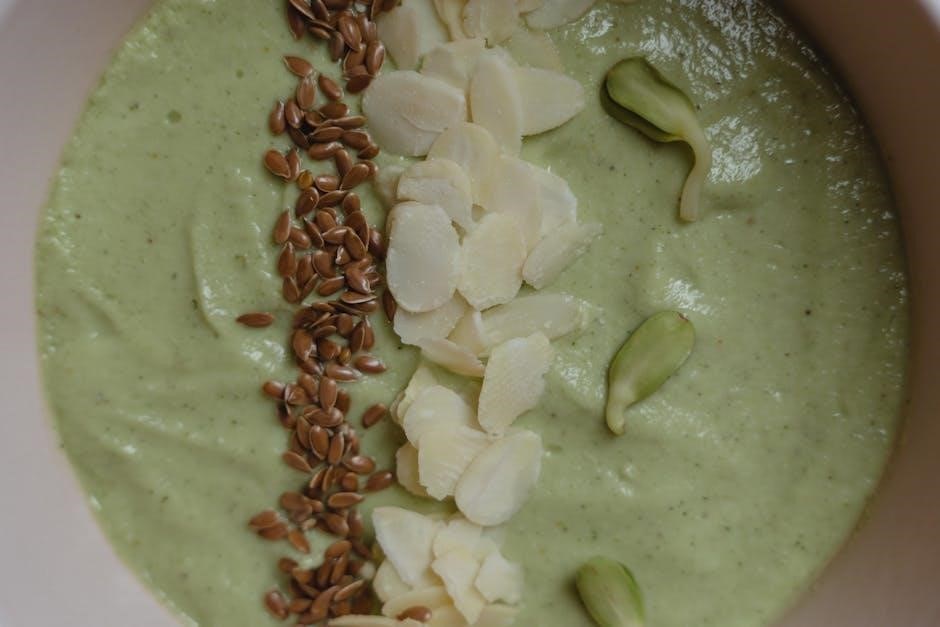A low sulfur diet reduces sulfur intake to improve digestion and overall health. Sulfur is essential for amino acids and minerals, but excessive levels can cause discomfort.
1.1 What is a Low Sulfur Diet?
A low sulfur diet involves reducing sulfur-rich foods like meats, dairy, and cruciferous vegetables. It aims to minimize sulfur intake while maintaining essential levels for amino acids and minerals. This dietary approach helps alleviate symptoms linked to sulfur sensitivity and promotes digestive balance, requiring careful planning to avoid nutrient deficiencies and ensure overall health benefits.
1.2 Importance of Sulfur in the Body
Sulfur is crucial for synthesizing amino acids like cysteine and methionine, essential for proteins and detoxification. It aids in antioxidant production and maintaining healthy skin, hair, and nails. Sulfur also supports joint health and is involved in metabolism, making it vital for overall bodily functions while balancing intake to avoid potential harmful effects for some individuals.

Benefits of a Low Sulfur Diet
A low sulfur diet offers various health improvements, including improved digestion, reduced inflammation, and relief from chronic conditions. It enhances detoxification processes, promoting overall well-being and long-term health benefits.
2.1 Improved Digestion and Reduced Inflammation
A low sulfur diet can significantly improve digestion by reducing bloating and gas. Lower sulfur intake minimizes discomfort from sulfur-sensitive guts, promoting a balanced digestive system. This approach also reduces inflammation, which can alleviate symptoms of conditions like irritable bowel syndrome (IBS) and other digestive disorders, fostering a healthier gastrointestinal environment overall.
2.2 Potential Relief from Chronic Conditions
A low sulfur diet may offer relief for individuals with chronic conditions like kidney disease, where excessive sulfur can worsen symptoms. It can also benefit those with sulfur metabolism disorders or sensitivities. Additionally, reducing sulfur intake may help manage heart health by lowering homocysteine levels, which are linked to sulfur-containing amino acids. Consulting a healthcare professional is essential for personalized benefits.
2.3 Enhanced Detoxification Processes
A low sulfur diet may enhance detoxification by reducing the body’s sulfur burden, which can strain the liver and kidneys. Sulfur is involved in detox pathways, but excessive levels can overload these systems. Lowering sulfur intake may improve the efficiency of these processes, supporting overall health and reducing toxin buildup more effectively.

Foods to Avoid on a Low Sulfur Diet
High sulfur foods, such as cruciferous vegetables, dairy, and processed items, should be limited. These can increase sulfur intake, potentially causing digestive discomfort and inflammation.
3.1 High Sulfur Proteins and Dairy Products
High sulfur proteins, such as meat, fish, poultry, eggs, and dairy products, contain sulfur-rich amino acids like cysteine and methionine. These foods can increase sulfur levels in the body, potentially leading to bloating, gas, and discomfort. Reducing intake of these items is crucial for managing sulfur-related digestive issues and inflammation.
3.2 Sulfur-Rich Vegetables and Legumes
Vegetables like garlic, onions, broccoli, Brussels sprouts, and legumes such as lentils and beans are high in sulfur content. These foods contribute to sulfur buildup, potentially causing digestive discomfort. Limiting their intake is essential for adhering to a low sulfur diet and minimizing related health issues.
3.3 Processed Foods and Hidden Sulfur Sources
Processed foods often contain hidden sulfur sources, including preservatives and additives. Foods like deli meats, baked goods, and snacks may have sulfites or sulfur-based compounds. Limiting these can help reduce sulfur intake, as they contribute to overall sulfur levels and may exacerbate digestive issues for those on a low sulfur diet.

Foods to Include on a Low Sulfur Diet
Focus on fresh, low-sulfur options like fruits, vegetables, and whole grains. Include healthy fats and oils to support overall nutrition while minimizing sulfur intake.
4.1 Low Sulfur Fruits and Vegetables
Opt for low-sulfur fruits like bananas, apples, and berries. Vegetables such as leafy greens, carrots, and zucchini are also ideal. These options support digestion and reduce inflammation while providing essential nutrients. Incorporating a variety ensures balanced nutrition without excessive sulfur intake.
4.2 Whole Grains and Starches
Incorporate whole grains like rice, oats, and quinoa, as well as starchy vegetables such as potatoes and corn. These options are naturally low in sulfur, providing sustained energy and fiber. They aid digestion and are rich in nutrients, making them excellent choices for a balanced low sulfur diet.
4.3 Healthy Fats and Oils
Healthy fats and oils, such as avocado oil, olive oil, and coconut oil, are excellent for a low sulfur diet. They are naturally low in sulfur and provide essential fatty acids that support heart health and hormone production. These versatile oils also support brain function and aid in absorbing fat-soluble vitamins, offering anti-inflammatory benefits.

Meal Planning and Recipes
Plan balanced meals using low-sulfur ingredients to ensure variety and nutrition. Explore simple recipes tailored to reduce sulfur intake while maintaining flavor and dietary balance.
5.1 Breakfast Ideas for a Low Sulfur Diet
Start your day with low-sulfur options like oatmeal with fresh berries, scrambled eggs with spinach, or smoothies made with low-sulfur fruits. Incorporate whole grains and healthy fats to keep meals balanced and nutritious. Avoid high-sulfur foods like cheese or processed meats. Plan ahead to ensure variety and flavor in your breakfast routine while adhering to dietary guidelines.
5.2 Lunch and Dinner Recipes
Explore delicious low-sulfur meals with grilled fish, quinoa, and steamed vegetables. Try chicken stir-fries with carrots and bell peppers, or vegetable-based dishes like stuffed bell peppers. Opt for brown rice and sautéed mushrooms, ensuring flavors come from herbs and spices. Plan meals to avoid high-sulfur ingredients while maintaining nutritional balance and variety, keeping recipes simple and enjoyable for long-term adherence.
5.3 Snacks and Desserts
Enjoy low-sulfur snacks like fresh fruit, such as berries or apples, and opt for nuts like almonds or macadamia nuts in moderation. For desserts, consider sorbet, fruit salads, or dark chocolate in small portions. These options are naturally low in sulfur and offer a sweet, satisfying treat while supporting your dietary goals. Keep portions controlled to maintain balance and enjoy guilt-free indulgence.

Health Considerations and Risks
A low sulfur diet requires careful balancing, as sulfur is crucial for amino acids and detoxification. Excessive reduction can lead to deficiency, impacting overall health.
6.1 Sulfur Deficiency and Its Effects
Sulfur deficiency can lead to fatigue, skin issues, and impaired detoxification. It disrupts amino acid production and antioxidant function, potentially weakening immunity and metabolic processes over time.
6.2 Impact on Antioxidant Production
Sulfur is vital for producing antioxidants like glutathione, which protects cells from oxidative damage. A deficiency can impair antioxidant synthesis, leading to increased oxidative stress and potentially weakening the immune system and detoxification processes.
6.3 Special Diets and Conditions
A low sulfur diet may be beneficial for individuals with specific conditions, such as kidney disease, where excessive sulfur can burden the body. It can also aid those with digestive sensitivities, as high sulfur foods often cause bloating. However, balancing sulfur intake is crucial, especially for vegans or vegetarians relying on sulfur-rich plant proteins for nutrition.

Long-Term Sustainability
Long-term adherence to a low sulfur diet requires careful planning and variety to ensure nutrient balance and prevent monotony, making it sustainable for overall well-being.
7.1 Tips for Maintaining a Low Sulfur Diet
Plan meals in advance, incorporating low-sulfur foods like fruits, vegetables, and grains. Keep a variety of options to avoid monotony. Shop for fresh ingredients regularly to ensure availability. Use low-sulfur substitutes in recipes and consult a nutritionist for personalized advice. Track progress and adjust as needed to maintain long-term adherence and enjoy balanced nutrition.
7.2 Monitoring Progress and Adjustments
Regularly track your symptoms and dietary intake to assess progress. Adjust food choices based on how your body responds. Monitor energy levels, digestion, and overall well-being. Consult a nutritionist to refine your plan and address challenges. Be patient and flexible, as adjustments may be needed to maintain long-term success and health benefits.
A low sulfur diet can effectively improve health by reducing discomfort and inflammation. Balancing nutrition while minimizing sulfur intake is key for long-term success and well-being.
8.1 Final Thoughts on the Low Sulfur Diet
A low sulfur diet offers significant health benefits, including improved digestion and reduced inflammation. By carefully planning meals and balancing nutrition, individuals can sustain this diet long-term. It’s essential to weigh the benefits against potential risks, ensuring adequate nutrient intake. With proper management, a low sulfur diet can be a valuable approach to enhancing overall well-being and managing chronic conditions effectively;
8.2 Encouragement for Healthy Eating
Embracing a low sulfur diet can be a transformative step toward better health. By focusing on fresh, nutrient-rich foods and avoiding high-sulfur options, you can enhance digestion and reduce inflammation. Stay committed, explore creative recipes, and celebrate small victories. Remember, healthy eating is a journey, and each mindful choice brings you closer to long-term well-being and vitality. Consult a healthcare provider to ensure it’s the right choice for your needs.
